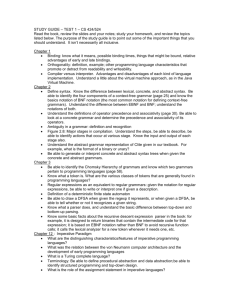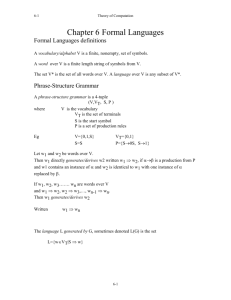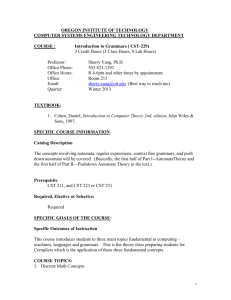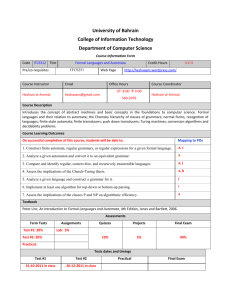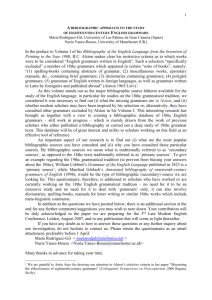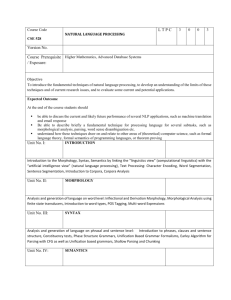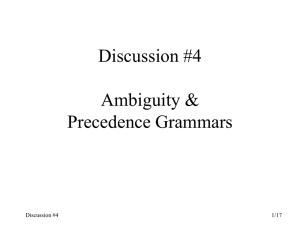Constraint Based Design
advertisement
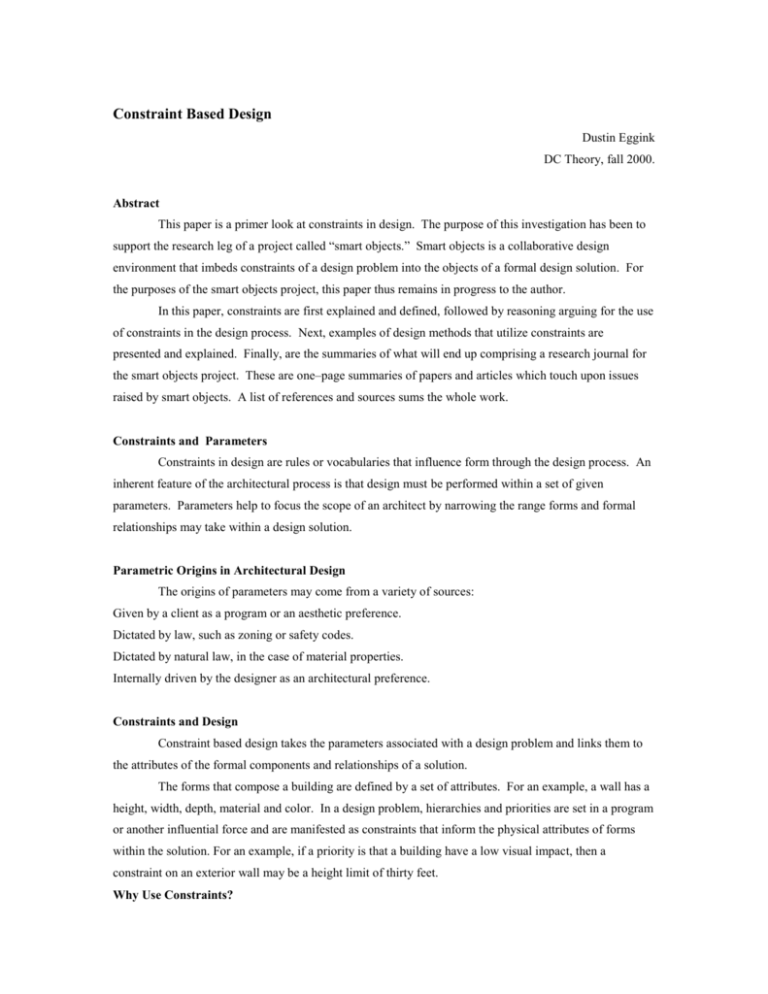
Constraint Based Design Dustin Eggink DC Theory, fall 2000. Abstract This paper is a primer look at constraints in design. The purpose of this investigation has been to support the research leg of a project called “smart objects.” Smart objects is a collaborative design environment that imbeds constraints of a design problem into the objects of a formal design solution. For the purposes of the smart objects project, this paper thus remains in progress to the author. In this paper, constraints are first explained and defined, followed by reasoning arguing for the use of constraints in the design process. Next, examples of design methods that utilize constraints are presented and explained. Finally, are the summaries of what will end up comprising a research journal for the smart objects project. These are one–page summaries of papers and articles which touch upon issues raised by smart objects. A list of references and sources sums the whole work. Constraints and Parameters Constraints in design are rules or vocabularies that influence form through the design process. An inherent feature of the architectural process is that design must be performed within a set of given parameters. Parameters help to focus the scope of an architect by narrowing the range forms and formal relationships may take within a design solution. Parametric Origins in Architectural Design The origins of parameters may come from a variety of sources: Given by a client as a program or an aesthetic preference. Dictated by law, such as zoning or safety codes. Dictated by natural law, in the case of material properties. Internally driven by the designer as an architectural preference. Constraints and Design Constraint based design takes the parameters associated with a design problem and links them to the attributes of the formal components and relationships of a solution. The forms that compose a building are defined by a set of attributes. For an example, a wall has a height, width, depth, material and color. In a design problem, hierarchies and priorities are set in a program or another influential force and are manifested as constraints that inform the physical attributes of forms within the solution. For an example, if a priority is that a building have a low visual impact, then a constraint on an exterior wall may be a height limit of thirty feet. Why Use Constraints? "Designers solve formal problems by establishing constraints. Their rules or constraints are not always explicit or rational, but are frequently based on the exploration of alternative solutions. " (Wojtowicz, 17.) 1. Constraints and Complexity. Experienced designers know well the limitations that come as part of any design problem. While many try their best to satisfy all the specified requirements, some will inevitably slip away. This can be due to disregard, misinterpretation, or forgetfulness of the specific nature of the problem. An architectural solution is judged by the way it has met and satisfied the needs at hand. Therefore, if something within the typical process of architecture is routinely diminishing the measure of its success, it is a problem worth investigation. Vitruvius defined architecture as a combination of commodity, firmness, and delight. That's three constraints to start off with. If that were it, the practice of architecture may be manageable. However, the three Vitruvian conditions are not simple statements and can be very nuanced problems individually with many sub-parameters. In separate books in the 1960's, both Robert Venturi and Christopher Alexander stated that the practice of architecture had become so complicated in the twentieth century by advances in building technology and modern methods of habitation, that the design approach to architecture must be changed. Venturi advocated an embrace of the complex and contradictory natures of architecture against the prevalent tendency towards simplification of modernism. Alexander went one step further by stating that many architectural problems were out of the grasp of a single architect, regardless of design tactic. "Today functional problems are becoming less simple all the time, but designers rarely confess their inability to solve them. Instead, when a designer does not understand a problem clearly enough to find the order it really calls for, he falls back on some arbitrary chosen formal order. The problem, because of its complexity remains unsolved." (pg. 1) Alexander recommends a method of breaking apart a design problem into manageable components as a way to best insure that the demands a context has upon the form set within it is met. Constraints attributed to formal solutions in architecture can be used as a means to keep the parameters and guidelines that must be met in a design problem conscious and understood to the designer. Donald Schon promoted a similar line of thought when he wrote: "Drawing functions as a context for experiment precisely because it enables the designer to eliminate features of the real-world situation which might confound or disrupt his experiments. But when he comes to interpret the results of his experiments, he must remember the factors that have been eliminated. " ( Jabi, 274) 2. Constraints and Representation. Even given the complexity of architectural design, the range of viable solutions to a design problem remains wide. The use of constraints can be used as method of way finding in the design process. This is accomplished foremost by forcing the designer to explicitly state a problem and the characteristics of its solution. This act allows design alternatives to be more quickly produced and evaluated because the desired attributes of a solution have been clearly stated and thus open to criticism and speculation. Constraints can also be useful in understanding the characteristics of style. Architectural styles of the past and present come complete with many rules and guides. Constraints can be used to understand the stylistic characteristics of a given design and provide design direction toward similarity or contrast. Design Constraint Examples Rules and parameters help create an overall unity and organization to a design. In some form or another, constraints as a means to influence form has been used for a long time. Ancient Greek architecture used an extensive ordering system to regulate the proportion and placement of formal elements of buildings. This is a tradition that has more or less passed through the stylistic periods of western architecture to the present. Constraint based design has been used as both a means to produce original design, and as a way to formalize and explain the process of design. Following are examples of design methods which utilize constraints as a method of design. Shape Grammars “A shape grammar is a precise set of generating rules.” (Wojtowicz, 43.) Shape grammars seek to find a language of shapes and relationships that order the formal composition of a whole. Grammars have recently been advanced for two reasons: they have proven useful in other fields, and they have been successful at analyzing individual designs, work spanning a career by a single architect, and entire movements in architecture. Given the name, shape grammars can be associated to written or spoken language. Language grammars order the finite elements given to a language and create rules of production for new pieces. For an example, every verb has a subject; and in German, the verb in every sentence is place second, unless a question is stated, in which case it is placed first. With language grammars, one can communicate effectively in a native or foreign tongue and produce original spoken or written works. Grammars have also been used extensively in music. Music is a highly relational form of art because it can only be experienced a single element at a time. For music to make any sense, a note must be considered as part of a context. Combinations of notes and the spaces between are taken as a whole to create the rhythms, harmonies and crescendos that define the art of music. Therefore, just a single word must be used with others within a grammar system to make any sense, a piece of music also uses a grammar to organize what would be an amorphous mass of sound into a composition. Shape grammars consist of a left hand side and a right hand side. Between these two, a transformation occurs. “The rule can be applied to a given shape if it contains a sub-shape which matches the left-hand side of the rule; when the rule is applied the sub-shape is replaced by another sub-shape corresponding to the righthand side of the rule.” (Wojtowicz, 44.) “I am making a basic distinction between architecture as moulding and architecture as assembly of parts. That seems a very simple distinction: the mud house, the stone masonry. But in fact it represents a fundamental intellectual difference, not just technical one.” (Bronowski, 57.) In architecture, shape grammars have been best used for analysis of built form. This is because the product of architecture is an assembly of parts, and grammars are systems for setting rules to the parts to the overall whole. Certain works of architecture are famous for compositional movements within the piece. For an example, the windows in LeCorbusier’s Ronchamp: Each window in south façade is different from any other but they all follow the same set of rules for their production. The rules apply to the cross-section, taper and perpendicular axis of the window. By applying the same shape grammar, one could produce similar but different windows in the same design aesthetic. As grammars apply to a single building, grammars have also been deduced to describe works by particular architects. Over a career, architects typically refer to a tailored set of design moves repeatedly. The overall forms produced may be unique, but rules to derive them are fairly standard. From the example above, a similar set of rules can be applied to LeCorbusier’s La Tourette. Therefore, the entire breadth of a career can mostly be broken down into a limited set of rules, as can whole stylistic movements in architecture. The advantage to shape grammars is that they are precise and non-preferential. Like design in general, they do not point to any one solution but to a range of possibilities. Shape grammars can also be altered during the design process, which can subtly alter or radically change the composite form of a design. If design is the exploration of alternatives, then shape grammars is a helpful means of navigation. However, shape grammars are not used extensively because they are hard to implement. Shape grammars are complicated and difficult to understand by most designers. While grammars are excellent for understanding the complexity of a design, the complexity serves as a deterent from implementing it as a design method. Feng-shui Stated simply, Feng-shui is the art of placing objects. Unknown to westerners until recently, feng-shui is principally used for home and office design. The position of objects is examined in relation to other objects and the context and is judged positive or negative based on the flow of “ch’i”. Ch’I represents energy and must be evenly circulated through a house. Feng-shui calls for balance as a principle means to regulate the flow of ch’i. Objects are assigned attributes of either ying or yang, and then placed relative to one another in order to maintain balance. Feng-shui utilizes a structure of "if, then" statements to determine the placement of objects next to each other. For an example, "if" a house is located close to a busy road, "then" plant a row of trees to block the noise and fumes. Within these statements, choices are possible to remedy the “if.” Typically, the options are additive in nature. In the example above, an item (a row of trees) was added to the site in order to correct the unbalance created by another item (the busy road.) Another option could have been to slow down the road. However, feng-shui not only acts as a guide for initial design but also as a method for remedying conflicts. This implication is important because it addresses the reality of givens within a design problem. Additionally, everything is considered relatively. The implication of feng-shui is that there are no absolutes. The value of an object is calculated in accordance to its context and the balance of the whole (building, landscape or office) is placed above any one feature. Other Examples and Instances What follows is a brief summary of papers and articles I’ve read relating to the subject of constraint-based design. These one page summaries, for the most part, cover experimental design related computer programs written by researchers, students and faculty at universities around the world. Some of these programs specifically address constraints in design, others, the collaborative process. References: Alexander, Christopher. Notes on the Synthesis of Form. Cambridge, Massachusetts: Harvard University Press, 1964. An early study on how the complexities in a design problem can be broken into manageable groups. Frazier, John. “Plastic Modelling- the Flexible Modelling of the Logic of Struccture and Spaces,” Proceedings from CAAD Futures ’87. (199-208.) New York, Elsvier Science Publishers, 1988. A description of a computer modelling program that describes relationships between elements and spaces. Gero, John and Saunders, Robert. “Constructed Representations and Their Functions in Computational Models of Designing,” Proceedings from CAADRIA 2000. (215-224.) Centre for Advanced Studies in Architecture, Singapore, 2000. A description of levels of perception in design representation and a program that can monitor the progression of representation in the design process. Gross, Mark. Design as Exploring Constraints. Cambridge, Massachusetts: Massachusetts Institute of Technology, 1986. A doctoral dissertation using computer programming to define and explore design constraints. Jabi, Wassim. “The Role of Artifacts in Collaborative Design,” Proceedings from CAADRIA ’98. Center for Advanced Studies in Architecture, Singapore, 1998. A report on a digital collaborative design studio and a reflection on the digital design process. Kilkelly, Michael. Off the Page: Object-Oriented Construction Drawings. Proceedings ACADIA National Conference 2000, Washington D.C. A description of a computer program that allows elements in construction drawings to respond to changes between each other. Krishnamurti, Ramesh and Stouffs, Ruid. “Spatial Grammars: Motivation, Comparison, and New Results,” Proceedings from CAAD Futures ’93. (57-74.) Elsevier Science Publishers, Amsterdam, 1993. A defense of shape grammars and the potential application in a computer environment. Kwok, Man-Ho The Feng-Shui Kit. Charles E. Tuttle Co., Boston, MA. 1995. An introduction to Feng-shui in home and office design. Venturi, Robert. Complexity and Contradiction in Architecture. New York, New York. Museum of Modern Art, 1966. A defense for acknowledging and embracing the disparate elements of architecture. Wojitowicz, Jerzy and Fawcett, William. Architecrture; Formal Approach. St. Martin’s Press, New York. 1986. Descriptions of shape grammars and the introduction of an expert design system.
